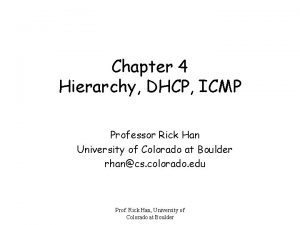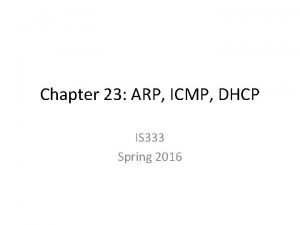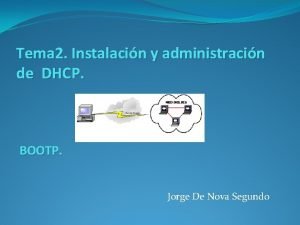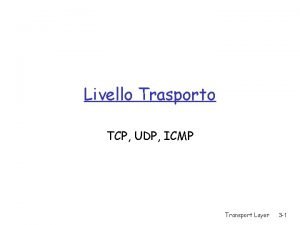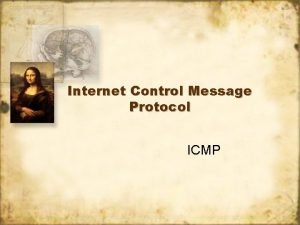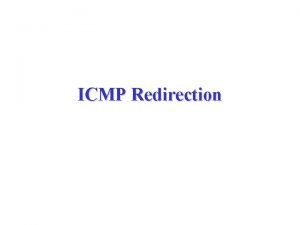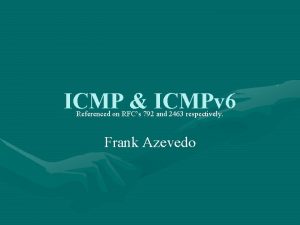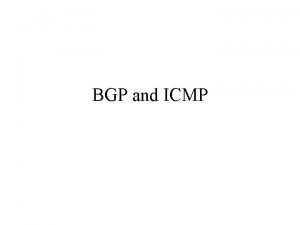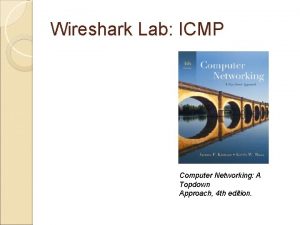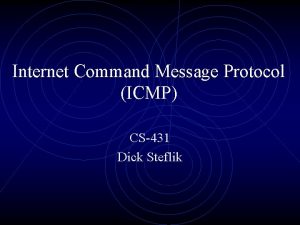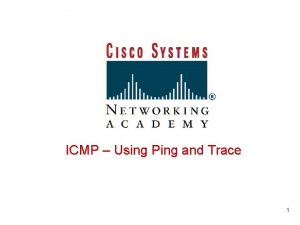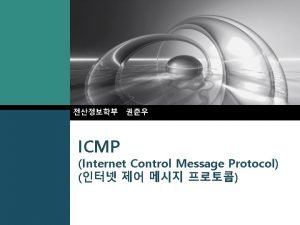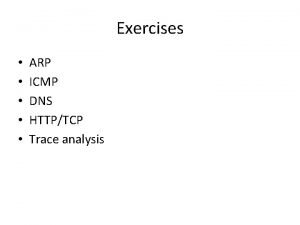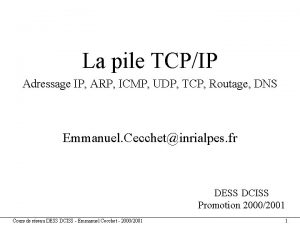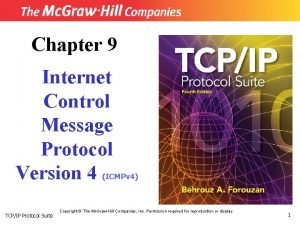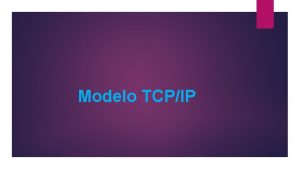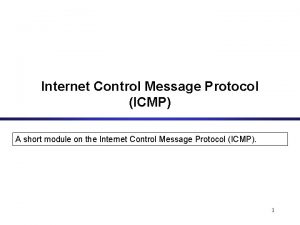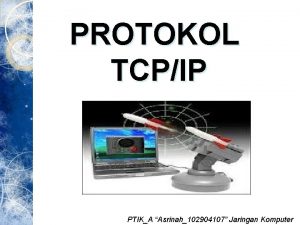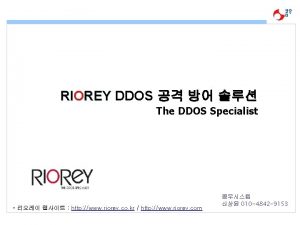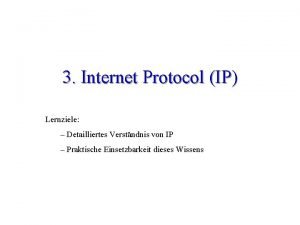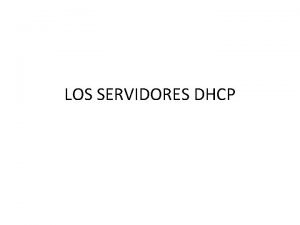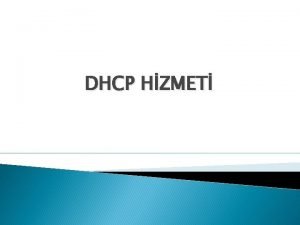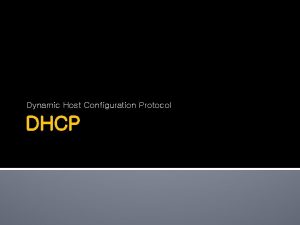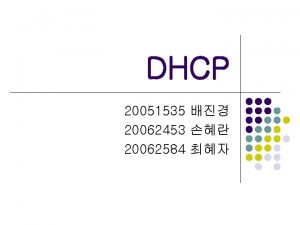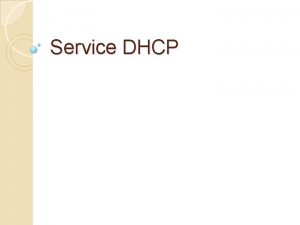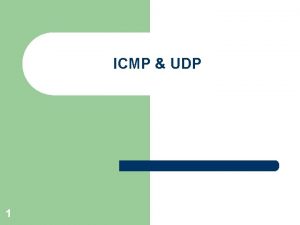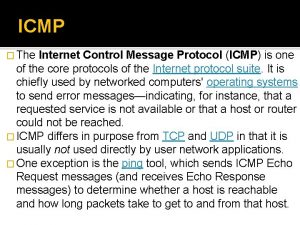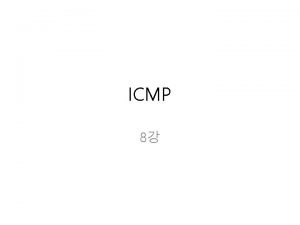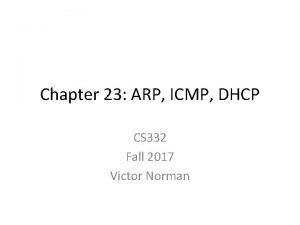Chapter 4 Hierarchy DHCP ICMP Professor Rick Han


























- Slides: 26

Chapter 4 Hierarchy, DHCP, ICMP Professor Rick Han University of Colorado at Boulder rhan@cs. colorado. edu Prof. Rick Han, University of Colorado at Boulder

Announcements • Homework #3 on Web, due March 12 (two weeks), netstat portion online later today • Programming Assignment #2 coming… • Midterm March 14 • Last week’s lectures on Web • Next, more on hierarchy, DHCP, ICMP, … Prof. Rick Han, University of Colorado at Boulder

Recap of Previous Lecture • Link State vs. Distance Vector • • • Routing Update Size Routing Update Comm. Overhead Convergence Speed Complexity Space Robustness • • • Queue Length Delay Normalized Hop Count • BGP • Link State Cost Metric • Hierarchical Routing Prof. Rick Han, University of Colorado at Boulder

Scalability in Internet Routing (2) AS 1 Inter-Domain Routing Border/ RIP Gateway Router Border/ Gateway Router Intra-Domain Routing. Prof. Rick Han, University of Colorado at Boulder AS 2 OSPF

Border Gateway Protocol (BGP) • Interdomain Routing • “Path” Vector similar to Distance Vector – BGP router advertises only reachability info in its vector, not costs/hop counts • E. g. networks 128. 96, 192. 4. 153, and 192. 4. 3 can be reached from AS 2 – BGP router advertises its path to each destination in its vector • Avoids loops Prof. Rick Han, University of Colorado at Boulder

Interior Border Gateway Protocol • Each AS may have many border routers – Each border routers could inject 10000 prefixes from neighboring AS • LSP’s too large • Shortest path calculations too expensive • Border routers use interior BGP (IBGP) to limit routing info received by internal AS routers – IBGP routers determine best route to each destination – Only the best interior BGP router injects info into AS – Any router in AS learns one best border router to use when sending a packet externally Prof. Rick Han, University of Colorado at Boulder

Hierarchy In Addition To BGP • OSPF has its own hierarchy: group OSPF routers into areas – Hierarchy: AS –> OSPF area -> OSPF network • Subnets: – Fixed Classes A, B, C inefficient - Class B exhaustion – Subdivide a Class B IP address 128. 96. 34. 15 into <Network ID, Subnet ID, Host ID> • IP address is AND’ed with subnet mask to extract subnet address: – Subnet mask 255. 0 AND’ed with IP address 128. 96. 34. 15 gives subnet address 128. 96. 34 – Subnet mask 255. 128 AND’ed with IP address 128. 96. 34. 15 gives subnet address 128. 96. 34. 0 Prof. Rick Han, University of Colorado at Boulder

Additional Hierarchy (2) • Subnets: – When host 1 wants to send to host 2, AND the subnet mask with the destination IP address • If result is same subnet as sending host 1, then send over local LAN subnet • If result differs, then route to another subnet using subnet -to-subnet routing – Forwarding table changes from <destination IP, next hop> to <destination subnet, subnet mask, next hop> • For each entry, router AND’s subnet mask with dest. IP address and looks for match with destination subnet • Longest match breaks a tie Prof. Rick Han, University of Colorado at Boulder

Additional Hierarchy (3) • CIDR (Classless Interdomain Routing) Subnets: – When subnet mask is top N bits, then have a CIDR network prefix, • 192. 4. 16 with 20 bit prefix is written 192. 4. 16/20 • Approaches for fast prefix matching • How do nodes advertise their CIDR prefix/mask? – IP header only has 32 -bit address • Where is subnet mask? – BGP-4 path vectors and OSPF LSP’s carry the CIDR prefix along with the IP address, e. g. 192. 4. 16/20 Prof. Rick Han, University of Colorado at Boulder

Additional Hierarchy (4) • How do CIDR and non-CIDR routing stay compatible? – OSPF and BGP support CIDR, RIP does not – RIP builds a routing table by falling back to the old Class A, B, C network prefixes • makes RIP more inefficient • Packets are still routed correctly • CIDR Bottom line: – Improves address assignment efficiency – Helps aggregate routing to occur between networks rather than nodes Prof. Rick Han, University of Colorado at Boulder

Fast Matching of Variable Prefixes • Need to match CIDR network prefix with IP packet’s destination address – Brute force: for each destination router in list • apply mask to match prefix with destination address’s prefix • choose longest match Prof. Rick Han, University of Colorado at Boulder

Fast Matching of Variable Prefixes (2) • Speeding it up: Organize prefixes into a Patricia tree – If Nth bit is zero, go left, otherwise go right – Automatically finds longest match – Worst case = 32 bit tests 1 0 default 0/0 0 128. 2/16 Bit to test : 0 = left child, 1 = right child 0 1 1 0 163. 32/16 1 192. 3/20 Prof. Rick Han, University of Colorado at Boulder 252. 32. 150/24

Dynamic Host Configuration Protocol (DHCP) • RARP: A host knows a destination’s MAC address, but not destination’s IP address. • If destination=itself, then same goal as DHCP • BOOTP: similar goal to RARP, devised same time (1985) • DHCP: a host knows its own MAC address, but doesn’t have an IP address yet • Due to hierarchical addressing on network, can’t have manufacturer-preassigned IP addresses • Manual configuration is time-consuming, inflexible to changes, wastes addresses on disconnected nodes Prof. Rick Han, University of Colorado at Boulder

DHCP (2) • Goal: Automatic configuration of a host’s IP address – A host queries a DHCP server to obtain an IP address • How does a host find the address of a DHCP server? – Host sends a DHCPDISCOVER “limited IP broadcast packet”, with destination address 255 – Routers never forward such a packet, so it stays within LAN IP Router 255 LAN 1 Requesting Host LAN 2 DHCP Server Prof. Rick Han, University of Colorado at Boulder

DHCP (3) • DHCP relays enable one DHCP server per administrative domain, rather than one server per network – Requires a DHCP relay on each network – DHCP relay sends a unicast IP packet to DHCP server when it hears a local IP broadcast packet with DHCPDISCOVER 255 IP Router LAN 1 Requesting Host DHCP Relay Prof. Rick Han, University of Colorado at Boulder LAN 2 DHCP Server

DHCP (4) • DHCP server selects a dynamic IP addr. from pool – maps host’s MAC address to the dynamic IP address • Another advantage of relays: enable DHCP responses to get back to requesting host – Server can’t send directly back using host’s MAC address – DHCP server sends unicast to known IP address of DHCP relay, which sends to host’s local MAC address IP Router LAN 1 Requesting Host DHCP Relay Prof. Rick Han, University of Colorado at Boulder LAN 2 DHCP Server

DHCP (5) • Hosts cannot keep dynamic IP addresses indefinitely – Timeout/lease by DHCP • 3 days for Windows NT, 8 days for Windows 2000, 1 day… • Configurable when starting DHCP server – Host must periodically renew lease, otherwise IP address goes back into pool of available addresses • DHCP is implemented as an application-level protocol on top of UDP and IP Prof. Rick Han, University of Colorado at Boulder

Internet Control Message Protocol (ICMP) • Used for reporting errors in the Internet – Most ICMP packets contain diagnostic info sent back to source • Destination unreachable • TTL expired • Implemented at the same level as transport protocols, just above IP – Nevertheless, all IP routers are expected to speak ICMP IP Header ICMP message Protocol=ICMP Prof. Rick Han, University of Colorado at Boulder

ICMP (2) • Already seen it in use: – Ping – Traceroute – Discovery of local routers on a LAN • Format of an ICMP message: – Some Types: • • Type Code Cksum ICMP body Echo & Echo Reply *Destination Unreachable : dest not in routing table, or down *Source Quench : sent by router during congestion Redirect Router Advertisement Router Solication *Time Exceeded : TTL Expired Prof. Rick Han, University of Colorado at Boulder * = most frequently used

ICMP (3) • ICMP body often contains a copy of IP header (+ first 8 bytes of payload) of packet that generated the ICMP message • Ping: – A host sends an ICMP “echo” message – As IP packet, “echo” message gets routed to destination – At destination, respond by sending an ICMP “echo reply” message • Swap source and destination IP addresses and recompute checksum Prof. Rick Han, University of Colorado at Boulder

“Smurf” Denial of Service Attack via ICMP echo • Ping an IP broadcast address using spoofed source IP addr, e. g. ping 255 – All nodes on LAN respond to ICMP echo with ICMP echo request, directed at source – LAN and especially source are flooded • Solutions: – Patch OS to disallow ICMP echo request to ICMP echo using IP broadcast address – Don’t allow router to forward external IP broadcast addresses into your LAN Prof. Rick Han, University of Colorado at Boulder

Traceroute and ICMP • Trace the route of an IP packet – A host sends a regular IP packet to destination IP address with TTL of one – First router in path decrements TTL to zero, and sends back to source a “Time exceeded” ICMP message • Source address in ICMP message is first router on path ! – Increment TTL by one (TTL=2), next ICMP error message sent by second router in path – Keep incrementing TTL to find routers in path Prof. Rick Han, University of Colorado at Boulder

Traceroute and ICMP (2) • Trace the route of an IP packet Source Router 1 Timeline: Router 2 TTL=1 Router 1 known Router 2 known Destination known TTL=2 TTL=3 Prof. Rick Han, University of Colorado at Boulder Destination

Traceroute and ICMP (3) • Trace the route of an IP packet – Upon reaching destination, • No “Time exceeded” message generated • How do you know when final destination is reached? – Traceroute sends to unused UDP port (>30000), generating an ICMP “destination unreachable” message • With code “port unreachable” Prof. Rick Han, University of Colorado at Boulder

Router Discovery via ICMP • Routers periodically broadcast their ICMP router advertisement to local LAN – About every 7 minutes – Lifetime of 30 minutes • New hosts can broadcast ICMP router solicitation message, to avoid waiting 7 minutes • ICMP Redirect – Sent when there are two or more routers on the same LAN – Each router will know whether its neighbors on a LAN are closer to a destination • When source sends to higher cost router, that router sends an ICMP Redirect message to the source Prof. Rick Han, University of Colorado at Boulder

IP Tunnelling and VPN’s • IP router 1 builds an IP tunnel to IP router 2 – Router 1 encapsulates packets destined for network/LAN 2 with router 2’s IP address – Router 2 de-encapsulates • Advantages – Secure tunnels = Virtual Private Networks (VPNs) for corporations – Layered functionality = multicast/MBone – Encapsulate non-IP protocols LAN 1 R 1 Internet Prof. Rick Han, University of Colorado at Boulder R 2 LAN 2
 Dhcp icmp
Dhcp icmp Dhcp icmp
Dhcp icmp Dhcp/bootp in dhcp server
Dhcp/bootp in dhcp server Promotion from assistant to associate professor
Promotion from assistant to associate professor Livello transport
Livello transport Icmp type 8 code 0
Icmp type 8 code 0 Icmp redirect attack tutorial
Icmp redirect attack tutorial Icmp rfc
Icmp rfc 2 bytes =
2 bytes = Icmp in computer networks
Icmp in computer networks Udp header
Udp header Bgp icmp
Bgp icmp Wireshark lab ip
Wireshark lab ip Mrtg ping
Mrtg ping Icmp subtypes
Icmp subtypes Canvas icmp
Canvas icmp Traceroute use icmp
Traceroute use icmp Vvvv logo
Vvvv logo Arp icmp
Arp icmp Pile tcp ip
Pile tcp ip During error reporting, icmp always reports error messages
During error reporting, icmp always reports error messages Icmp modelo osi
Icmp modelo osi Icmp protocol header
Icmp protocol header Protok
Protok Pengertian protokol adalah... *
Pengertian protokol adalah... * Riorey
Riorey Ip header vs tcp header
Ip header vs tcp header
